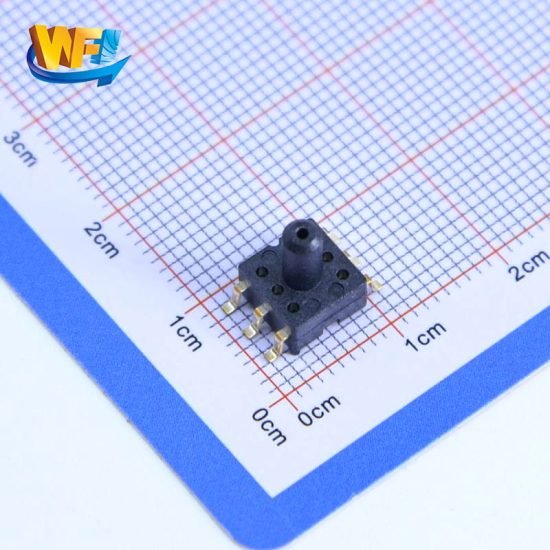목록
일반적인 압력 센서 문제를 해결하는 방법
압력 센서는 다양한 산업 및 상업용 응용 분야에서 필수적인 구성 요소로, 다양한 프로세스를 제어하고 모니터링하는 데 중요한 실시간 압력 측정 기능을 제공합니다. 그러나 모든 기계 장치와 마찬가지로 압력 센서도 때때로 작동하지 않을 수 있습니다. 이 기사에서는 WF 압력 센서 및 기타 센서를 진단하고 수리하는 방법을 포함하여 일반적인 압력 센서 문제를 해결하는 방법에 대한 가이드를 제공합니다.
출력 또는 불안정한 출력이 없습니다
압력 변환기에 출력이 없거나 불규칙한 출력이 있는 경우 변환기의 전기 연결이나 변환기 자체에 문제가 있을 수 있습니다. 핀을 점검하여 연결이 올바른지 확인하고 멀티미터 또는 기압 센서 모듈을 사용하여 센서 출력 전압을 테스트하십시오. 전압이 지정된 범위 내에 있으면 센서 자체에 문제가 있을 수 있습니다. 이 경우 WFsensors 기술 지원팀에 문의하여 도움을 받으십시오.
제로 출력
압력 변환기가 0을 출력하는 경우 변환기의 전기 연결, 변환기의 공급 전압 또는 변환기의 내부 전자 장치에 문제가 있을 수 있습니다. 배선 핀아웃 다이어그램과 공급 전압을 확인하여 올바르게 연결되고 지정된 범위 내에 있는지 확인하십시오. 핀이 납땜되어 있고 전압이 올바른 경우 센서의 내부 전자 장치에 문제가 있을 수 있습니다. 이 경우 공장 지원팀에 문의하여 도움을 받으십시오.
범위 외 출력
압력 변환기의 측정된 출력이 압력 범위를 벗어나는 경우 과도한 압력, 변환기 결함 또는 변환기 교정 문제 때문일 수 있습니다. 압력이 센서의 정격 범위 내에 있는지 확인하십시오. 압력이 지정된 범위 내에 있으면 센서나 교정에 문제가 있을 수 있습니다. 이 경우 공장에 연락하여 새로운 공기압 센서를 요청할 수 있습니다.

비고: SOP 및 DIP 패키지 제품의 연결 정의는 동일합니다.
느리거나 지연된 응답
압력 변환기의 반응이 느리거나 지연되는 경우 변환기의 전자 장치, 배선 또는 교정에 문제가 있기 때문일 수 있습니다. 배선 연결이 올바르고 부식이 없는지 확인하십시오. 센서 교정을 점검하여 지정된 한계 내에 있는지 확인하십시오. 납땜된 핀 연결과 보정이 올바른 경우 센서의 내부 전자 장치에 문제가 있을 수 있습니다.
온도 드리프트
압력 변환기에 온도 드리프트가 발생하는 경우 변환기의 보상 회로 또는 변환기 교정에 문제가 있기 때문일 수 있습니다. 핀 배선을 점검하여 연결이 올바르고 부식이 없는지 확인하십시오. 센서의 교정을 점검하여 지정된 범위 내에 있는지 확인하십시오. 배선과 교정이 올바른 경우 센서의 보상 회로에 문제가 있을 수 있습니다.

압력 센서가 작동하지 않는 이유는 무엇입니까?
환경 적 요인
가혹한 환경은 센서 성능에 큰 영향을 미칠 수 있습니다. 극한의 온도, 습도, 부식성 물질 및 진동에 노출되면 마모가 가속화될 수 있습니다. 적절한 인클로저와 코팅으로 센서를 보호하는 것이 필수적입니다.
전기 오버 스트레스
전압 스파이크 또는 정전기 방전(ESD)과 같은 전기적 과도한 스트레스는 센서의 내부 전자 장치를 손상시킬 수 있습니다. 적절한 접지, 서지 보호 및 주의 깊은 취급으로 이러한 문제를 예방할 수 있습니다.
오염
먼지, 기름, 화학 물질과 같은 오염 물질이 있으면 센서의 압력 포트가 막히거나 내부 부품이 부식될 수 있습니다. 정기적인 청소와 필터 사용으로 오염으로 인한 고장을 예방할 수 있습니다.
일반적인 압력 센서 문제를 해결하는 방법
초기 점검
육안 검사: 균열, 부식, 느슨한 연결 등 눈에 보이는 손상이 있는지 확인하십시오.
배선: 센서의 데이터시트에 따라 모든 배선 연결이 안전하고 올바르게 배선되었는지 확인하십시오.
전원 공급 장치: 센서가 올바른 공급 전압을 받고 있는지 확인하십시오. 전압이 부족한 경우가 많습니다.
압력 점검
알려진 압력을 적용하십시오: 보정된 압력 소스를 사용하여 알려진 압력을 센서에 적용합니다.
읽기를 비교하십시오: 센서의 출력을 예상값과 비교합니다. 큰 편차가 있으면 문제가 있음을 나타냅니다.
누출을 확인하십시오: 센서 판독값에 영향을 미칠 수 있는 압력 라인이나 피팅에 누출이 없는지 확인하십시오.
- 신호 컨디셔닝: 신호 조절 회로에 결함이 있는 연산 증폭기나 저항기와 같은 문제가 있는지 확인하십시오.
결론
위의 소개는 압력 센서 기술 적용의 표면적인 부분에 불과합니다. 우리는 다양한 제품에 사용되는 다양한 유형의 센서 요소, 작동 방식, 장점과 단점을 계속해서 탐구할 것입니다. 여기에서 논의된 내용에 대해 더 자세히 알아보려면 이 가이드 뒷부분의 관련 콘텐츠를 확인하세요. 시간이 촉박한 경우 여기를 클릭하여 이 가이드의 세부정보를 다운로드할 수도 있습니다. 공기 압력 센서 제품 PDF 데이터.
다른 센서 기술에 대한 자세한 내용은 다음을 참조하십시오. 센서 페이지를 방문하십시오.
